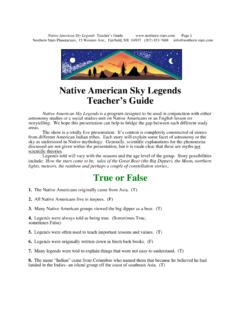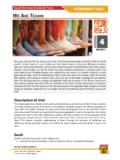Transcription of Canadian Aboriginal Astronomy Resource List final3
1 Resource Guide for Canadian Aboriginal Astronomy (May 2010). Prune Harris, Institute for Integrative Science & Health, Cape Breton University A highly successful International Year of Astronomy (IYA2009) has come and gone and we are now living the experience of Beyond IYA, with time to process and integrate our understandings of the rich, diverse and multidisciplinary materials available. This Resource Guide has been compiled by Prune Harris as part of the work of the Canadian Aboriginal Working Group for IYA2009. The working group emerged by special request from the Canadian IYA National Steering Committee to Cape Breton University (CBU) because of the university's globally unique Integrative Science program that brings together Indigenous and Western scientific knowledges and ways of knowing and because of the university's dynamic Mi'kmaq College Institute (MCI).
2 Through discussions in various community programs run by the Integrative Science team, it became apparent that many educators feel overwhelmed when trying to access information on Astronomy , and that this situation is exacerbated when looking for information on Canadian Aboriginal Astronomy . Thus was born this project to compile a Resource Guide. Its listings include both printed and web-based materials; as possible, I have also provided brief annotation. All the materials are nontechnical and therefore appropriate for students, educators, and others interested in Canadian Aboriginal Astronomy .
3 The Integrative Science team includes Mi'kmaq Elders and educators, Canada Research Chair Dr. Cheryl Bartlett, students, and Research Associates. Integrative Science is defined as bringing together Indigenous and Western scientific knowledges and ways of knowing and the team is pioneering praxis-based research using integrative, action, and participatory methodologies within a co-learning journey with, by, and for Aboriginal peoples and communities. It was conceived in the mid-1990s in collaboration with key Mi'kmaq individuals to bring radical innovation into the educational system to begin to address the under-participation by Aboriginal young people in university science programs and thus also in careers that require science education.
4 Within this co-learning journey, Mi'kmaq Elder Albert Marshall has brought forward the guiding principle of Two-Eyed Seeing which emphasizes learning to see from one eye with the strengths in Indigenous knowledges and ways, and learning to see from the other eye with the strengths in Eurocentric (or Western, or mainstream) knowledges and ways. Elder Albert stresses that we humans must learn to use these two eyes together, for the benefit of all. In the effort to help educators work with the understandings offered by Two-Eyed Seeing, I have provided references in the section entitled Two-Eyed Seeing Resources for Educators.
5 The Resource Guide is intended as a living document and thus is by no means exhaustive. Also, in that it is only a compilation of resources, it is not to be interpreted as an effort to verify the authenticity and/or accuracy of the information in the materials listed. We welcome comments, additions and suggestions to the list, as posted on the Integrative Science website at 1. Two-Eyed Seeing Resources for Educators Bartlett, C., Marshall, M., Marshall, A., and Iwama, M. Integrative Science and Two-Eyed Seeing: Enriching the Discussion Framework for Healthy Communities.
6 In: Ecologically Emancipated Communities. Edited by: L. Hallstrom. UBC Press (forthcoming). Bartlett, 2009. Mother Earth, Grandfather Sun. Green Teacher, 86: 29-32. Hatcher, AM. and Bartlett, C. 2009. Traditional medicines: how much is enough? Green Teacher, 86: 11-13. Harris, P., Bartlett, , Marshall, M., and Marshall, A. Mi'kmaq Night Sky Stories; patterns of interconnectiveness, vitality and nourishment. Communicating Astronomy to the Public Journal (in press). Hatcher, AM., Bartlett, , Marshall, A., and Marshall, M. 2009. Two-Eyed Seeing in the classroom environment: concepts, approach and challenges.
7 Canadian Journal of Science, Mathematics, and Technology Education, 9(3): 141-153. Hatcher, , and Bartlett, C. 2009. MSIT: transdisciplinary, cross-cultural science. Green Teacher, 86: 7-9. Hatcher, , Bartlett, C., Marshall, M., and Marshall, A. 2009. Two-Eyed Seeing: a cross- cultural science journey. Green Teacher, 86: 3-6. Hatcher, , Kavanagh, S., Bartlett, C. and Marshall, M. 2009. Traditional legends: meanings on many levels. Green Teacher, 86: 14-17. Iwama, M., Marshall, M., Marshall, A. and Bartlett, C. Two-Eyed Seeing and the language of healing in community-based research.
8 Canadian Journal of Native Education (in press). Website for Integrative Science: Aboriginal Sky Stories Bruchac, Joseph. 1989. Return of the Sun: Native american Tales from the Northeast Woodlands. The Crossing Press. Grade 4 and up. Almost all these stories came, at least in part, from living oral tradition and many are here translated from their original languages. There is great variety, including The return of the Sun (Onondaga), which tells how the Sun came to be fastened up into the sky so that it can give light and life to the people. Buck, Wilfred.
9 2009. Atchakosuk: Ininewuk Stories of the Stars. First Nations Perspectives, 2, 1 (2009), 71-83. =0. 2. The article explores atchakosuk - the spirit lights up above. Ininewuk (Cree). mythology posits that constellations and stars that are prominent in the northern skies are understood through perspectives that are unique to the Ininewuk. For First Nations students and Ininewuk students in particular, it is important that the ancestral worldviews related to the natural world are reflected in First Nations education, as most cultures have their own interpretations and understandings of constellations and the stories associated with them.
10 The Knowledge Keepers, Medicine People, and honoured Elders that have graced us with these understandings are from many nations as far away as South America and as close as our home communities. The author has chosen to deal specifically with Ininewuk perspectives of Astronomy for this is where his path began. The subject matter is intended to provide students and educators associated with First Nations education with an introduction to Ininewuk perspectives. In this article, the Ininewuk language is in the Swampy Cree dialect. Chandra, Nalini and Percy, John.





